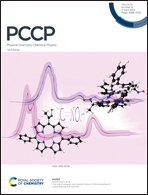Folding and modulation of the helical conformation of Glycophorin A by point mutations†
Abstract
Transmembrane helix folding and self-association play important roles in biological signaling and transportation pathways across biomembranes. With molecular simulations, studies to explore the structural biochemistry of this process have been limited to focusing on individual fragments of this process – either helix formation or dimerization. While at an atomistic resolution, it can be prohibitive to access long spatio-temporal scales, at the coarse grained (CG) level, current methods either employ additional constraints to prevent spontaneous unfolding or have a low resolution on sidechain beads that restricts the study of dimer disruption caused by mutations. To address these research gaps, in this work, we apply our recent, in-house developed CG model (ProMPT) to study the folding and dimerization of Glycophorin A (GpA) and its mutants in the presence of Dodecyl-phosphocholine (DPC) micelles. Our results first validate the two-stage model that folding and dimerization are independent events for transmembrane helices and found a positive correlation between helix folding and DPC-peptide contacts. The wild type (WT) GpA is observed to be a right-handed dimer with specific GxxxG contacts, which agrees with experimental findings. Specific point mutations reveal several features responsible for the structural stability of GpA. While the T87L mutant forms anti-parallel dimers due to an absence of T87 interhelical hydrogen bonds, a slight loss in helicity and a hinge-like feature at the GxxxG region develops for the G79L mutant. We note that the local changes in the hydrophobic environment, affected by the point mutation, contribute to the development of this helical bend. This work presents a holistic overview of the structural stability of GpA in a micellar environment, while taking secondary structural fluctuations into account. Moreover, it presents opportunities for applications of computationally efficient CG models to study conformational alterations of transmembrane proteins that have physiological relevance.



 Please wait while we load your content...
Please wait while we load your content...